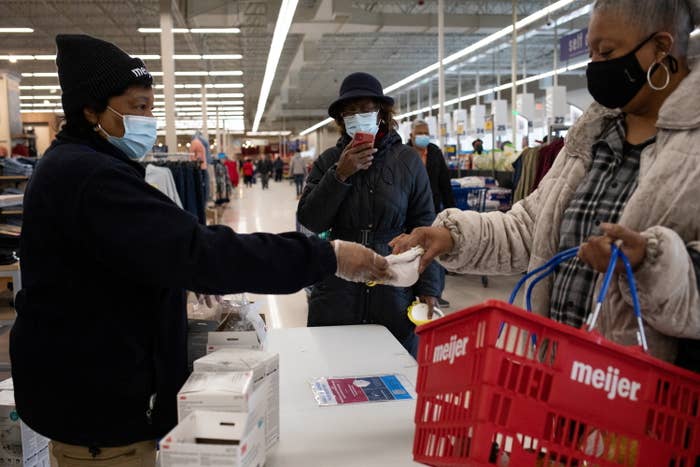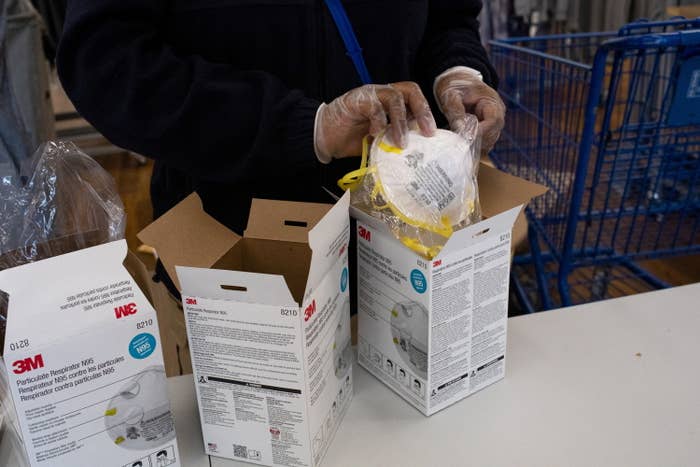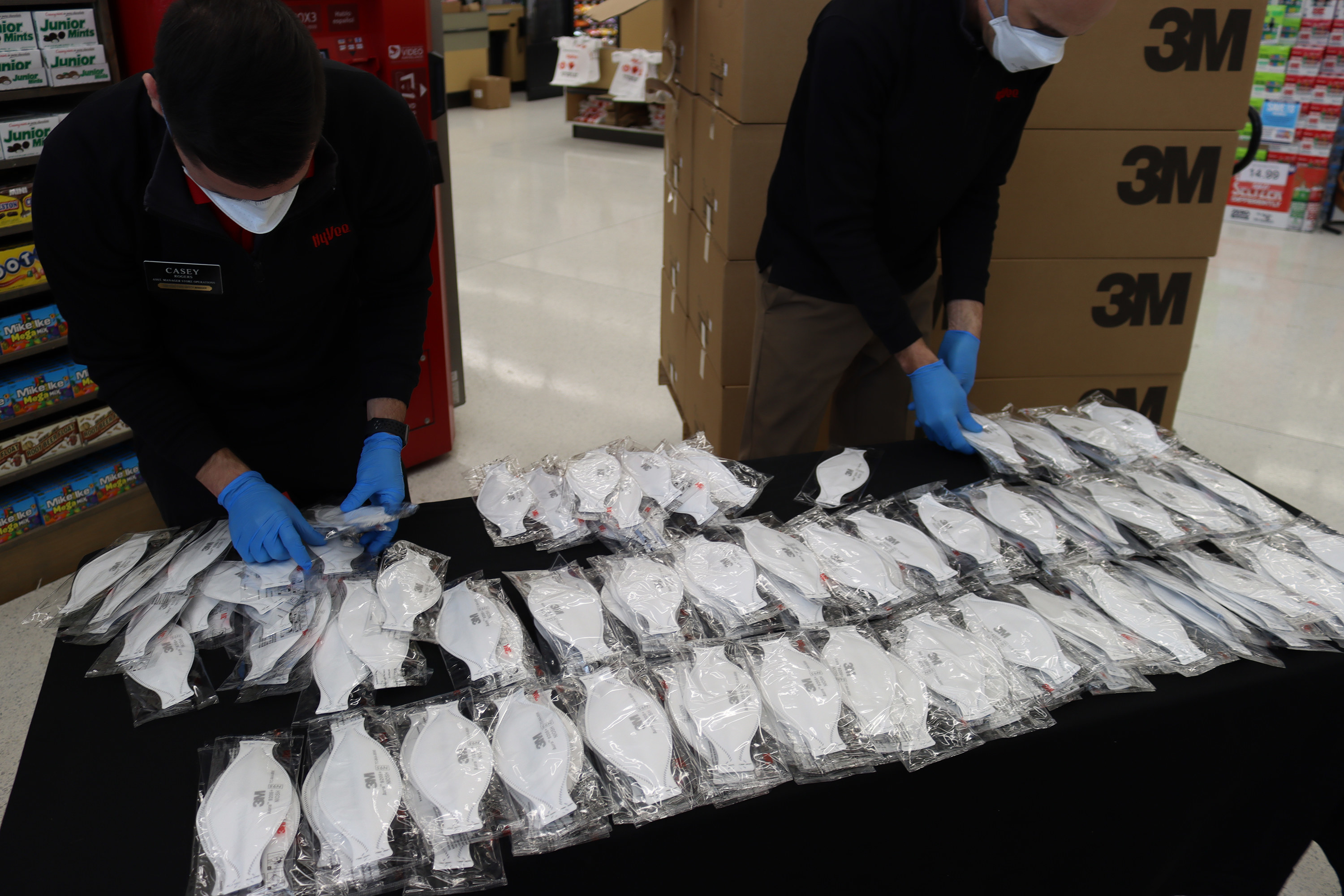
In what the government is calling the “largest deployment of personal protective equipment in US history,” millions of free nonsurgical N95 respirators will arrive at pharmacies and community health centers starting this week.
You can get up to three free N95 masks until the stockpile runs out. All you have to do is visit a participating location (which will have signs indicating availability) and pick them up — no questions asked or documentation needed.
One caveat: The masks are adult-sized, so you may need to explore other options for your kids. The CDC recommends that everyone ages 2 or older wears a mask in public indoor places. (Masks aren’t appropriate for younger toddlers or babies.)
With the highly transmissible Omicron variant spreading around the world, the CDC recently updated its mask guidance. While sticking to the same message as before — any mask is better than no mask — the agency stressed a close fit is super important for masks and that well-fitted N95s “offer the highest level of protection” against COVID.
Despite the roller coaster that has been public health messaging on face coverings in general (remember those videos about making your own mask from dish towels and T-shirts?), experts say the late but welcome emphasis on high-quality masks is a promising — yet still flawed — step in the right direction.
Dr. Abraar Karan, an infectious disease doctor and global health researcher at Stanford University, told BuzzFeed News that he thinks the CDC needs to clarify that people should upgrade to higher-quality face masks instead of leaving it up to them to figure out what’s most “comfortable.”
Some grocery store pharmacies in Iowa, Michigan, Ohio, Indiana, Illinois, Kentucky, and Wisconsin have already begun handing out the masks to interested shoppers, a spokesperson for the US Department of Health and Human Services told BuzzFeed News.
You’ll be able to pick up your free N95s from some CVS stores beginning Thursday, Jan. 27, and from Walgreens beginning Friday, Jan. 28, the companies told us. Walmart is expecting to hand out the free masks at its stores, and Sam’s Club locations by the second week of February. Just look for signs that indicate your nearest stores have some available.
The US-made masks will continue to roll out in more states as the week progresses, but the program, which will ship a total of 400 million N95s across the country, will be fully operating by early February.
Supplies come from the Strategic National Stockpile, which has tripled its mask reserve since January 2021 to more than 750 million N95 masks. The HHS said there will still be 350 million surgical N95s left for healthcare workers — nearly 20 times more masks than there are healthcare employees in the US, meaning shortages no longer plague the nation as they did early on in the pandemic, the spokesperson confirmed. The free masks aren’t exactly the same as the N95s used by healthcare workers, so you won’t be depriving anyone by using them.
But what makes N95s so special? Can you reuse them? And how do the respirators differ from other commonly used masks?
BuzzFeed has the answers to your questions.

What is a nonsurgical N95 mask?
A nonsurgical N95 respirator is a mask designed to fit snugly around your nose and mouth with straps that go around your head; it’s made of layered polypropylene, or plastic, fibers that effectively filter out 95% of any bacteria or virus particles you or others breathe, cough, or sneeze out — if worn properly and consistently.
The material uses the power of static electricity to catch incoming germs or particles as air passes through the tiny spaces between the fibers.
N95s are called “respirators” because they filter out tiny airborne particles. All other coverings, like surgical masks, aren’t “respirators” because they can’t effectively filter the air you breathe; they mostly help block large respiratory droplets that may carry germs from entering your mouth, like a snotty sneeze or phlegmy cough.
There are several different types and shapes of N95s; some look like duck bills, others like domes, and several have three panels.
The main difference between nonsurgical and surgical N95s is that the latter are also fluid resistant to protect doctors and nurses from blood and other bodily fluid sprays, Dr. David Banach, an infectious disease physician and hospital epidemiologist at UConn Health of the University of Connecticut, told BuzzFeed News.
N95 vs. KN95 mask: What's the difference?
The government is sending nonsurgical N95 respirators to the public because those are the masks that are available in the Strategic National Stockpile, the HHS spokesperson told us. But there are similarly effective respirators, such as KN95s commonly sold at stores like Home Depot, that you could use as well.
N95 respirators are regulated by the US with standards set by the National Institute for Occupational Safety and Health (NIOSH), while KN95s (and KF94s and others) follow international standards, meaning they also should screen out about 95% of germs and particles, but their effectiveness can vary between brands sold in the US. That’s why Banach advises extra caution if you choose to wear these masks.
The CDC found that about 60% of KN95s tested in 2020 and 2021 were less effective than advertised. That said, many of the KN95s had a filter efficiency of 90% or greater, although some counterfeit products had filtration efficiencies as low as 10% to 20%.
Both KN95s and KF94s offer the virus-catching electrostatic charge, so they should offer strong protection for you and others around you.
Legitimate N95s are approved by the CDC’s NIOSH and will have specific markings, including the NIOSH logo or block letters on them to indicate their authenticity.
Keep in mind that KN95s are not approved by NIOSH, so any claims to that effect suggests they are counterfeits.
Other signs of counterfeit N95 respirators are ear loops instead of an elastic band that goes around your head, no markings on the filtering facepiece, and a missing or misspelled NIOSH mark. Here are some pictures of counterfeit respirators from the CDC and a full list of companies that make NIOSH-approved face respirators that are similarly or more protective than N95s.
Is an N95 uncomfortable?
The biggest complaint people make about N95s is that they can be hard to wear, particularly in hot conditions or when you have to exert yourself. (N95s with exhalation valves can help improve breathability, but experts strongly recommend against these masks because they don’t filter the air you exhale — so they protect you, but not the people around you if you have COVID.)
Although it may take a bit more effort to breathe through N95s, NIOSH tests have shown some of the respirators have better overall breathability than cloth or surgical masks, Karan of Stanford said, so it could take some time before you find the right type for you.
On the more comfortable side are the loose-fitting and disposable surgical masks, which can offer high levels of protection against the coronavirus if worn properly (secured over your mouth, nose, and chin with minimal gaps). They are made of the same electrostatic material as N95s, but surgical masks don’t have the same fit or filters as their higher-quality counterparts.
Cloth masks could be anything from a scrap of T-shirt attached to two ear loops to a bandana. The CDC and other experts say these options offer the least protection against the coronavirus, though there are ways to lock in more protection, like layering it with a surgical mask.
How does the N95’s protection compare to other masks?
In its updated guidance, the CDC says well-fitting N95 respirators give the best protection for yourself and others, followed by KN95s and surgical masks, then cloth masks.
N95s and KN95s are about 90–95% or more protective against virus particles (but remember it could vary with KN95s), while surgical masks stand in the 50–60% range, Karan said. If you layer them with a cloth mask, you can reach between 70–75% protection.
Cloth masks alone, however, are as little as 20-40% effective, he added.

When should you wear an N95 mask?
If you find yourself periodically removing an N95 because it’s uncomfortable to wear, it’s not your best option. Experts suggest you try out different N95 mask shapes until one suits you.
Here’s when the CDC says you should really try to wear an N95 or other type of mask that offers high protection:
- You are caring for someone with COVID
- You are at increased risk because you are immunocompromised or have an underlying condition
- If you have a job, such as a bus driver or a grocery store worker, where you interact with a lot of people
- You are traveling on planes or other forms of public transportation where you might be crowded in with other people for long periods of time
- You are at crowded indoor or outdoor places where you can’t social distance
- You don’t have all of your recommended COVID vaccinations
Who should avoid wearing N95 masks?
If you have chronic respiratory, heart, or other medical conditions that make it hard to breathe, you should talk with your doctor before adding N95 masks to your COVID repertoire, the US Food and Drug Administration and other experts say.
Have facial hair? You may need to shave it or wear a “mask fitter or brace” the CDC says, because tiny gaps in your beard may allow unfiltered air to seep in and out.
Banach of UConn Health admits people with claustrophobia may also struggle wearing N95s.
Can children wear N95s?
N95 respirators are tested and designed for adults, so they may not offer the best fit for kids. The government is also shipping only adult-sized masks, the HHS spokesperson told BuzzFeed News.
There are no NIOSH-approved N95 masks for kids, a CDC spokesperson confirmed, but some companies may make them, or others like KN95s, in smaller sizes.
At the minimum, Karan said, kids, particularly those with weakened immune systems, should wear well-fitted surgical masks, which are more comfortable and offer better protection than cloth masks. (Again, children under age 2 shouldn’t wear masks at all.)
The priority is to find a comfortable one that kids won’t tear off in seconds.
“Making sure it's snug and comfortable are the most important things with kids,” Banach said, “often even more so than the actual thickness and filtration of the mask.”
How to wear an N95 properly
Before putting your N95 mask on, you should check for markings that indicate the mask is authentic and look for any damages.
If all is good, cup the mask in your hand and hold it over your mouth and nose. Slide one strap over to the back of your head and place the other across your neck below your ears.
Make sure you put both straps to work, Banach said, otherwise you risk a loose fit and reduced protection, like wearing shoes without tied laces.
Next, press the wire above your nose to mold it to your face. You can perform a “seal check” by putting both hands on your mask and blowing out. Felt an air leak? Readjust your straps and nose wire.
If you find N95 masks too uncomfortable to wear for long periods of time, limit your use to situations that are high risk, such as crowded indoor spaces, Karan suggests.
“That's where you'll get the most bang for your buck,” he said.
Can you reuse N95s? How to know it’s time to trash your mask
Short answer: they aren’t designed to function beyond a single use, but it’s probably fine to reuse them, experts say. You can only receive three free N95s, and your exposure to the COVID-causing virus is generally not as intense as you go about your daily life compared with healthcare settings where masks are tossed after one use.
Karan recommends using a different N95 mask per day of the week, if you can; so you’ll have a Monday mask, Tuesday mask, and so on. That way you can let the mask air out for a week in between uses.
In fact, the more you wear your N95 respirator, the more effective it becomes, Karan said, because the filter gets clogged with particles that block others from coming in. However, breathability will decrease over time.
If you want to extend your N95’s shelf life, especially if you have only a couple on hand, you can wear a surgical mask over it when in high-risk settings or scenarios, Banach said.
Generally, double-masking is not recommended or needed with N95s.
When your mask is visibly dirty, gets damaged or fits loosely, or your straps become too stretched, then it's time to trash it, experts say.
The initial shipment of 400 million N95s will eventually run out, but the HHS spokesperson told BuzzFeed News it’s responding in “real-time” to demand and will replenish the stockpile as needed.
Can you disinfect or clean N95s?
There’s really no need to, Karan said, emphasizing the coronavirus is an airborne pathogen. “It’s not going to go from your mask to your hand and infect you.”
You’ll also risk damaging your mask, rendering it ineffective.
“For now, recycle your mask over a few weeks, get through this surge, and then I hope the US government will increase the supply to get people more masks and accessible options,” Karan said.
Do N95 masks expire?
N95 respirators do expire, Banach said, but it’s usually several years after they are made.
As long as you store your N95s according to its box instructions, you’ll be fine — unless you’re saving them for the next inevitable pandemic.
